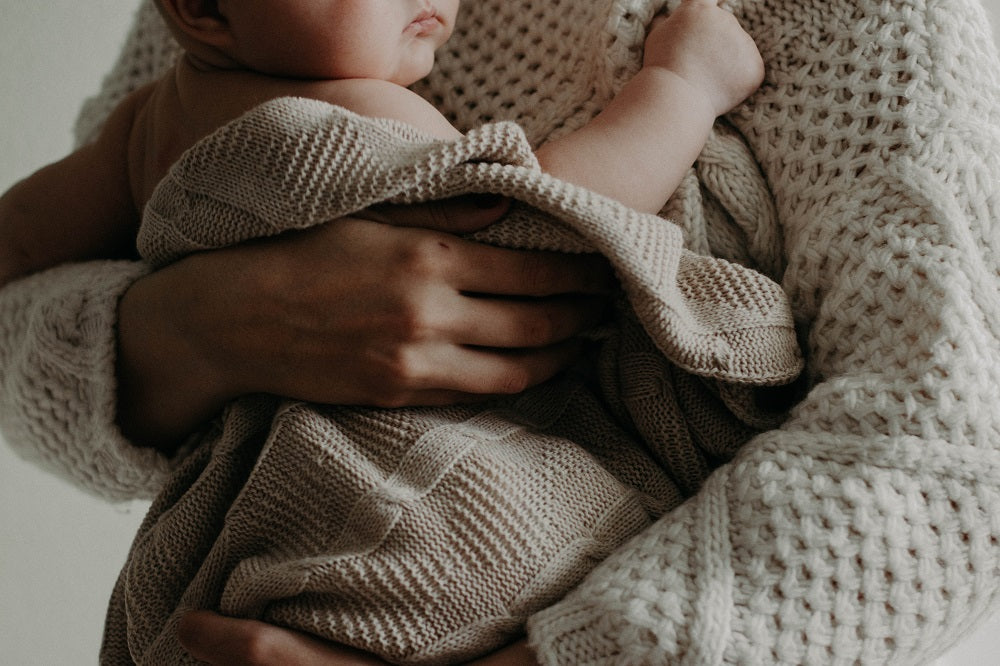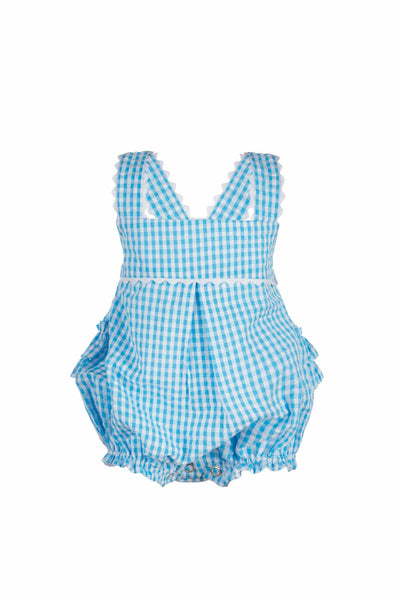How To Knit a Baby Blanket: 4 Steps and Learning the Basics

Knitting has been around for thousands of years - but with the computer age and new technology, there are so many new designs, patterns and projects to keep crochets in stitch all day long. Making or knitting a baby blanket is an absolute favorite pastime and a great way to use up yarn.
Table of Contents
- When Can Babies Sleep with a Blanket?
- 5 Types of Baby Blanket Knitting
- What You'll Need to Begin
- Instructions on How to Make a Baby Blanket
- Making the Blanket Larger
- Tips for Working with Yarn
- What is Gauge in Knitting?
- When to Start the Border?
- Conclusion
When Can Babies Sleep with a Blanket?
As soon as your baby is able to roll over by herself, she can start using a light blanket in her sleep. If you are using a quilt or afghan, make sure it is lightweight and super soft, so it doesn't pose a risk of suffocation should your baby's face become buried in it.
According to American Academy of Pediatrics (AAP), a good rule of thumb is to wait until your baby is at least 12 months or 1 year old before introducing a blanket into the crib.
Our Carriage Boutique Knit baby blankets are meticulously handcrafted with love and attention to detail. We use premium quality materials to guarantee the ultimate comfort for your little one.
What sets our blankets apart is their convenient machine-washable feature, which makes them a breeze to clean, perfect for busy parents like yourself!
5 Types of Baby Blanket Knitting
Different types of baby blankets can be created using various knitting techniques. The most popular types of blanket knitting include:
1. Garter Stitch

This is the most basic type of knitting stitch and results in a very thick, textured blanket. It is also one of the quickest to knit.
Garter stitch is created by knitting every row, meaning that you knit every stitch in every row. This creates a fabric that looks the same on both sides and has a ridged texture.
2. Seed Stitch

Seed Stitch - This stitch creates a more delicate looking blanket with a finer texture. It takes slightly longer to complete than the garter stitch.
To work the seed stitch, you will need to alternate between a knit stitch and a purl stitch on every row.
On the next row, reverse the stitches (knit the purls and purl the knits). Continue in this pattern until your project is complete.
3. Stockinette Stitch

This smooth, stitches minute fabrics strollers generally look best on simple patterns and can be combined with other stitch types.
It rolls at the edges unless countered with another type of stitch such as the seed or garter stitch.
Stockinette stitch is created by knitting one row and purling the next row, alternating back and forth.
4. Two-Color Garter Stitch

wo-Color Garter Stitch - As the name suggests, this technique uses two colors of yarn to create a striped effect in the finished blanket. It is easy to execute and is perfect for beginners.
To start, cast on your desired number of stitches in the first color. Next, you will knit one row with the first color and then switch to the second color for the next row.
Continue alternating colors until you reach the desired length of your blanket. When you are finished, bind off using the same color as your last row. This will create a garter stitch pattern that is striped with two colors.
5. Cable Knit

Cable Knit - This classic style gives any blanket a sophisticated look. It requires basic cable knitting knowledge and creates a sturdier fabric than other stitches.
The pattern is created by alternating knit and purl stitches and using a cable needle to switch the order of the stitches.
What You'll Need to Begin

Assuming you've never knit before, you'll need the following supplies or knit materials to get started on your baby blanket:
-
A pair of knitting needles. These can be made out of different materials like wood or metal, and come in various sizes. It's important to choose the right size needles for your project and yarn. A good rule of thumb is to use thicker needles for chunky yarn and thinner needles for thinner yarn. You can test out different materials and sizes to see what you prefer before starting your blanket.
-
Yarn. Again, there are many different types of yarn available in a wide range of colors. For a baby blanket, you'll want to choose something soft and durable like wool or cotton. Decide how much yarn you'll need based on the size of the blanket you want to make and the gauge of your needles (more on that later).
-
Scissors. You'll need these to cut your yarn when you're finished knitting.
-
A tape measure. This will come in handy to make sure your blanket is the right size as you work.
-
A stitch marker or piece of scrap yarn. This isn't strictly necessary, but it can be helpful to keep track of where you are in your pattern if it's complicated.
Instructions on How to Make a Baby Blanket
If you are new to knitting or have never made a baby newborn blanket before, don’t worry! These instructions will show you how to knit a simple blanket that can be completed in just a few hours. Once you have your supplies gathered, follow these steps to knit your own:
- Cast on 60 stitches onto your knitting needles. If you’re not sure how to do this, check out our handy tutorial on casting on.
- Knit every stitch until you reach the end of the row. Then turn your work and knit the next row. Repeat this process until your blanket measures approximately 36 inches long.
- When you reach the desired length, it’s time to bind off your stitches. Again, if you’re not sure how to do this, check out our binding off tutorial.
- Once all of your stitches are bound off, weave in any loose ends using your tapestry needle.
- Congratulations! You’ve now completed your very first baby blanket!
Making the Blanket Larger
If you're finding that your baby blanket is too small, there are a few things you can do to make it larger. First, check your gauge. If your gauge is off, that could be why your blanket is smaller than expected.
Once you have the correct gauge, you can try adding more stitches or rows to the blanket. If you're still not happy with the size of your blanket, you can always rip it out and start again! Checkout our article about Baby Swaddle: How to and When to Stop Swaddling Your Baby.
Tips for Working with Yarn
When working with yarn, there are a few things to keep in mind in order to make the process as smooth as possible:
- Firstly, it is important to choose the right type of yarn for your project. There are many different types of yarn available on the market, so it is important to do some research beforehand to find out which one will work best for your needs.
- Secondly, you will need to gauge how much yarn you will need for your project. This can be done by measuring the length and width of your desired project and then calculating the amount of yarn required accordingly.
- Finally, it is important to wind your yarn into balls before beginning your project. This will help prevent tangles and make it easier to work with.
What is Gauge in Knitting?
Gauge is the number of stitches and rows in a given space that equals a certain width. In knitting, gauge refers to the number of stitches and rows per inch (or 2.54cm). The gauge is important because it ensures your final product will be the correct size.
If you knit too tightly, your item will be smaller than the pattern says it should be. If you knit too loosely, your item will be larger than the pattern says it should be. You can check your gauge by measuring a swatch of your knitting to see if it matches the gauge given in the pattern.
If you're a new knitter, or are looking to expand your skills, learning how to knit a gauge swatch is a great place to start. Not only will this help you understand how your yarn and needles work together, but it will also give you a chance to practice your tension and create an accurate sample of your finished fabric.
When beginning any knitting project, it's important to check your gauge. This way, you can ensure that your finished item will be the right size and have the correct drape. While there are many ways to do this, we recommend starting with a gauge swatch.
A gauge swatch is simply a small sample of your planned fabric, made with the yarn and needles that you intend to use for your project. By knitting a gauge swatch and measuring it against the given specifications, you can determine whether or not your tension is accurate and adjust accordingly.
To knit a gauge swatch, start by casting on the number of stitches specified in the pattern (or slightly more). Then, work in the pattern stitch for several rows (or until the piece measures at least 4 inches). Finally, bind off all stitches and lightly block the swatch before measuring.
Once you've determined that your tension is accurate, you can move on to starting your baby blanket!
When to Start the Border?
One way to finish off your blanket is by adding a border. You can wait until the very end to do this, or you can start the border after a couple of inches. How wide you make the border is up to you, but 3-4 inches is usually enough.
If you're not sure when to start the border, here are a few things to consider:
-
The type of yarn you're using: if you're using a finer yarn, you may want to start the border sooner so it doesn't overwhelm the blanket.
-
The weight of the blanket: if your blanket is on the heavier side, starting the border sooner will help balance it out.
-
The design of the blanket: if your blanket has a lot of texture or color changes, starting the border sooner will help frame those elements.
Conclusion
By now you should have a good understanding of how to knit a baby blanket. You know the basics of what you need and how to get started.
Even if you don't feel like you're ready to tackle a baby blanket just yet, hopefully this article has given you the confidence to at least give it a try. So grab some yarn and needles and get started!
If you have no time, or not ready to make your own baby blanket yet, then visit our great collection of comfortable and high-quality knitted blankets for your newborn baby.





























Leave a comment